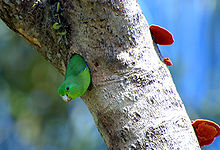Cobalt-rumped parrotlet
(F. x. flavescens) (F. x. flavissimus) Cobalt-rumped parrotlets are found in much of central and northern South America.
They occur in dry and riparian woodlands, cerrado, caatinga, palm groves, semi-arid scrubland, savanna, and pastures.
[3] Cobalt-rumped parrotlets are generally non-migratory; however, populations in Argentina move locally according to the flowering seasons of various plant species in their diet.
The cobalt-rumped parrotlet is not known to be affected by deforestation or the pet trade, unlike many of its close relatives in the genus Forpus.
[2] Cobalt-rumped parrotlets' breeding season is May to August, but occupied nests have been observed in July, January, and March in different areas of the birds' range.
[2] Some cobalt-rumped parrotlets have been observed to scrape rufous hornero nests (made of clay) with their beaks.
[9] However, similar studies of other Forpus species have concluded that clay-licking provides important minerals to the birds that otherwise would not be accessible.
[2] Cobalt-rumped parrotlets have been known to migrate locally based on the flowering and fruiting seasons of some of the main plants of their diet.
In 1978, Pinto mentioned the mistake in Novo Catálogo das Aves do Brazil and the name was changed to F. crassirostris.


